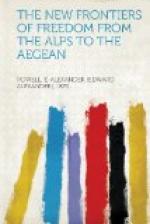Because I wished to follow Italy’s new frontiers from their very beginning, at that point where the boundaries of Italy, Austria and Switzerland meet near the Stelvio Pass, our course from Venice lay northwestward, across the dusty plains of Venetia, shimmering in the summer heat, the low, pleasant-looking villas of white or pink or sometimes pale blue stucco, set far back in blazing gardens, peering coyly out at us from between the ranks of stately cypresses which lined the highway, like daintily-gowned girls seeking an excuse for a flirtation. Dotting the Venetian plain are many quaint and charming towns of whose existence the tourist, traveling by train, never dreams, their massive walls, sometimes defended by moats and draw-bridges, bearing mute witness to this region’s stormy and romantic past. Towering above the red-tiled roofs of each of these Venetian plain-towns is its slender campanile, and, as each campanile is of distinctive design, it serves as a landmark by which the town can be identified from afar. Through the narrow, cobble-paved streets of Vicenza we swept, between rows of shops opening into cool, dim, vaulted porticoes, where the townspeople can lounge and stroll and gossip without exposing themselves to rain or sun; through Rovereto, noted for its silk-culture and for its old, old houses, superb examples of the domestic architecture of the Middle Ages, with faded frescoes on their quaint facades; and so up the rather monotonous and uninteresting valley of the Adige until, just as the sun was sinking behind the Adamello, whose snowy flanks were bathed in the rosy Alpenglow, we came roaring into Trent, the capital and center of the Trentino, which, together with Trieste and its adjacent territory, composed the regions commonly referred to by Italians before the war as Italia Irredenta—Unredeemed Italy.
Rooms had been reserved for us at the Hotel Trento, a famous tourist hostelry in pre-war days, which had been used as headquarters by the field-marshal commanding the Austrian forces in the Trentino, signs of its military occupation being visible in the scratched wood-work and ruined upholstery. The spurs of the Austrian staff officers on duty in Trent, as Major Rupert Hughes once remarked of the American staff officers on duty in Washington, must have been dripping with furniture polish.




